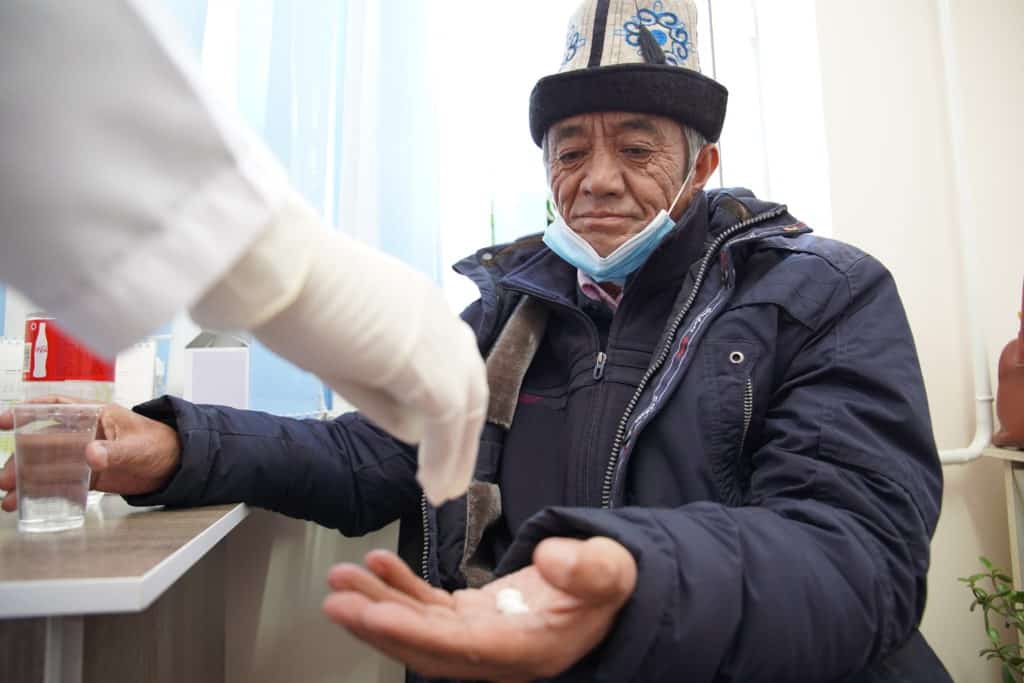This website uses cookies so that we can provide you with the best user experience possible. Cookie information is stored in your browser and performs functions such as recognizing you when you return to our website and helping our team to understand which sections of the website you find most interesting and useful.
After battling drug-resistant tuberculosis (DR-TB) for two years, Ishen Koldoev, 61, knows what it takes to be cured. “Patience,” he says. “Then, you need to take your medication on time. Only this gives a result.”
DR-TB treatment is long and complex and has potential side effects, which makes it difficult for patients to adhere to the treatment course. For Ishen, hope of leading a healthy and TB-free life became a reality thanks to consistent medical and psychological support from his health care workers and family in Kemin rayon of Chui Oblast.
For eight months following his diagnosis, Ishen received care and treatment in a specialized TB hospital. Afterwards he was transferred to outpatient treatment and received care from a health facility. Nurzhamal Mamytkazieva, a local nurse, brought Ishen his medicine every day since at first he was too weak to travel to the health facility. As he improved, his care was transferred to a feldsher-accoucher post (FAP), a facility that provides primary health care services, nearer to his home, which he visited on his own.
Nurzhamal, who has been working as a FAP nurse for 33 years, has seen firsthand how funding and new TB treatments have changed and improved the fight against TB in the Kyrgyz Republic. “It is only thanks to international TB interventions that we were able to cure him.”
“We’ve been fighting TB since I started working. In those days, treatment was in the hospital. Few people were treated at home; most stayed in hospitals. They would run away, fail treatment, and we had many TB cases,” says Nurzhamal. TB is no longer widespread where she works; there are only one or two cases a year among the 1,200 people who live in the village of Beisheke.
Patients are tested monthly to monitor their progress. A nurse collected Ishen’s sputum at the FAP, reducing his travel time, and delivered it to the rayon (district) medical center. Samples, including Ishen’s, are then picked up by a transportation agent and taken to the National Reference Laboratory (NRL) in Bishkek.
Because the specialized laboratories are located in regional centers and Bishkek, reliable transport for biological samples is crucial. USAID, through its TB programs, helped develop and implement a TB transportation system that delivers patients’ biological material to the specialized TB laboratories and the NRL. On the way back, transportation agents deliver drugs from regional TB centers to rayon medical centers.
The USAID-facilitated TB transportation system cut the diagnosis time from more than 90 days to less than a week, allowing patients to start treatment earlier and quickly adjust the treatment course if needed.
Before the new TB transportation system, health care workers had to use their own money to deliver sputum samples, which caused testing and diagnosis delays. Now, they fill out paperwork and are compensated for each trip. “It’s not much but we get paid. Before, this was not the case,” says Nurzhamal.
The USAID Cure Tuberculosis Project, implemented by JSI, worked closely with the Kyrgyz Government to mobilize funding from local sources and develop financing mechanisms and standards to allocate and institutionalize funding for the transportation system in Chui and Talas Oblasts, specifically from Kyrgyzstan’s Mandatory Health Insurance Fund, eventually aiming at a public-funded national transportation system for TB services. This relieved reliance on international funding and is more sustainable.
USAID Cure Tuberculosis transferred the transportation system to the government just before the onset of the COVID-19 pandemic. “Because of COVID, all private companies stopped operation but the state-run enterprises continued to deliver with unfailing regularity,” said Gulmira Kalmambetova, head of the NRL. “It was a wise decision to transfer the transportation system for TB services to state funding. During the COVID-19 crisis, the TB transportation system showed its self-reliance.”
Upon receiving his final test results from the NRL, Ishen rejoiced: he was cured. His commitment and adherence, coupled with patient-centered care from the local health care staff and his family helped him complete the two-year treatment and overcome the disease. “I wouldn’t wish this disease on anyone. To those who are being treated, I want to say take the medicine on time, you will definitely be cured.”
About the USAID Cure Tuberculosis Project
The project supports the Kyrgyz government to diagnose, treat, and cure people with DR-TB. The project works to strengthen systems, tools, resources, and human capacity to improve the Kyrgyz Republic’s response to TB in line with international recommendations.









